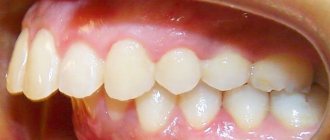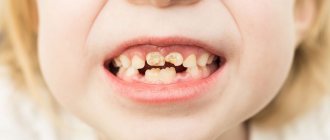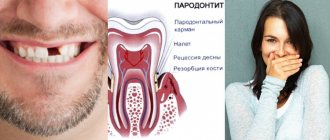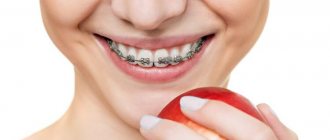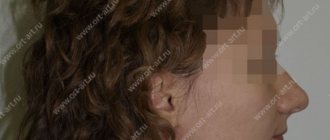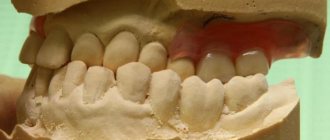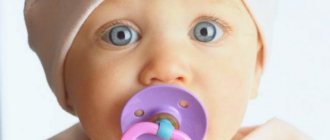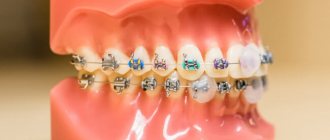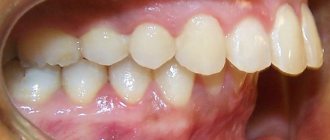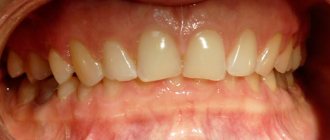How does a pacifier affect a child's bite?
The first stage of bite formation begins at birth and continues until the age of six months. At this time, the jaws are formed. As soon as the first teeth appear, the second stage begins (from 6 months to 3 years), during which the teeth are very mobile and susceptible to everything that affects them. And during this period, an incorrect bite may develop due to the pacifier.
The lower jaw of newborns is smaller in size compared to the upper. Her growth is activated through breastfeeding. This occurs when the lower jaw moves forward and the tongue makes a wave-like movement.
The bite from sucking a pacifier changes because the natural balance of the muscles is disrupted, which occurs as a result of the pressure of the tongue on the jaw line and contraction of the muscular apparatus of the cheeks and lips.
The pacifier affects teeth that have not yet erupted and displaces them in the wrong direction because it puts pressure on the periodontium and creates overload on the oral mucosa.
The effect of a pacifier on the bite is especially pronounced in those children who abuse it. In the future, a pathological bite such as a distal or open bite may develop, and the teeth of the upper jaw may also tilt strongly forward.
Important!
The effect of the pacifier on the bite occurs if it is used for six hours or more in total per day.
Does a pacifier affect a child's bite?
My baby is still sucking on a pacifier even though she is almost 2 years old. I don't give her a pacifier while she's awake, but if she cries a lot or when I put her to bed, I have to give her a pacifier. I bought a symmetrical pacifier (expensive, from an English company), the label stated that it does not spoil the bite, but my relatives and friends scold me, saying that it is at this age that the bite is formed, and I will spoil it for the child. Please give me some advice: should I wean her off the pacifier or does she still need to satisfy her sucking reflex? And can a modern pacifier really not ruin the bite, as stated on the label?
According to statistics provided by our orthodontists (specialists in the correction of dentofacial anomalies), ALMOST 42% OF EARLY CHILDREN HAVE AN IRON BITE. There are many reasons for this, and among them the leading place is the long-term use of a pacifier and (or) pacifier.
Why do babies need a pacifier? To suck. And sucking, in turn, is one of the very first reflexes that the body seeks to satisfy. If a baby sucks at the mother's breast, then his sucking reflex is fully satisfied due to the efforts he makes to extract milk from the breast. By the end of feeding, the baby even gets tired and, as a rule, falls asleep soundly. With artificial feeding, food is obtained easily. Therefore, the child has already eaten, but still wants to suck. This is where the “magic wand” comes to the rescue – the pacifier. It happens that parents themselves accustom their baby to a pacifier so that he does not needlessly bother them. This is how the pacifier becomes an irreplaceable and beloved “girlfriend” for a long time. He turns to it when he wants to sleep, calm down, or simply take his mind off “having nothing to do.”
By 7-9 months, the sucking reflex in infants fades away - by this time they are already eating well from a spoon and drinking from a cup (of course, if the mother has properly organized the child’s nutrition). A “dummy” “girlfriend” is needed less and less often. If the baby does not part with the pacifier, it means that something is wrong in his life, something is bothering him, for some reason he needs additional reassurance. And only the mother, together with the pediatrician, will be able to understand all the nuances of her child’s behavior.
As for the problem of bite formation, orthodontic specialists claim that ANY NIPPLE, DACTOR, OR THEIR “SUBSTITUTES” (FINGER, BLANKET EDGE, TONGUE, ETC.) CREATE AN INTERFERENCE WITH THE DEVELOPMENT OF THE FRONT TEETH, as they separate the bite. In order for a foreign object (pacifier or other) to prevent the teeth from growing properly, it must be in the mouth for at least 6 hours. Therefore, if a baby aged 1 to 2 years suffers and cries because he cannot sleep without his “girlfriend,” there is no need to give him additional stress. It is better to understand the situation, understand why a pacifier is needed, and, within reasonable limits, use a correctly selected pacifier (preferably one with a thin neck and a special “step” that ensures the correct positioning of the incisors and tongue). Immediately after falling asleep, you need to take the pacifier out of the baby's mouth. Make sure that during sleep the baby’s head is not thrown back or tilted too forward, so that the cheek does not rest against the pillow, because it will put pressure on the jaw and contribute to its curvature.
By the age of 2, both the pacifier and the pacifier must be gone from the child’s life. The process of “leaving” needs to be thought through, everyone has their own path, but it must be done.
Good luck to you!
What is more harmful – thumb sucking or pacifier sucking?
It is clear how the nipple is related to the bite. But children often put other objects and just their own fingers into their mouths. All this can also cause crooked teeth in the future.
Important!
If we compare the same frequency of use, the pacifier causes deformation of the palate to a lesser extent than the finger. It is much easier to give up a pacifier over time than a finger. If a child sucks his finger hard and a lot, it may become deformed and a deformity may form.
How to choose the right pacifier
The range of pacifiers is very large. There are also special nipples for proper bite, which contribute to the development of proper closure of future teeth. Their shape copies the mother's nipple. It is recommended to use these nipples for up to six months.
If there is deformation of the teeth from the pacifier, then there are different options for correcting this situation. This can be done using orthodontic pacifiers. The nipple for correcting the bite can be of various types:
- regular prophylactic plate;
- nipple with a visor, which develops the lower jaw;
- model with a flap that prevents the tongue from penetrating between the teeth;
- model with a bead that rolls and develops the tongue muscles.
There is a list of rules that allows you to choose the right pacifier.
- Nipples should be made of latex or silicone.
- The size of the pacifier should correspond to the age of the child. The pacifier spoils the bite if it is too large or too small.
- Preference should be given to orthodontic models.
- This item needs to be replaced every month and a half.
Types of abnormal bite
With improper occlusion, sagittal deviations occur on the sides of the dentition. If the closure is disturbed in the anterior region (in the smile zone), they speak of a vertical deviation. The following types of malocclusion are distinguished.
Distal. Occurs if the size of the lower jaw is reduced. It looks “pushed” back, the upper jaw hangs over it. With such a violation, the position of the upper incisors may be different:
- deflected outward towards the lip. The profile becomes concave, the lips may not close completely, the lower lip is slightly pulled up and forward to compensate for this;
- deflected inward, toward the sky. With this anomaly, a deep fold appears on the chin, the lower lip seems too thick.
A distal bite is formed due to thumb sucking in childhood, improper swallowing, in which the muscles of the lips and cheeks become tense, and due to the habit of biting the upper or lower lip. It is often explained with gradual changes in diet: food becomes softer, chewing load decreases, and this affects the dental system. With such a violation of occlusion, diction worsens, biting, chewing hard foods is complicated, and pain may occur at the ends of the dentition and in the jaw joint.
Mesial. The reverse of the previous anomaly: the upper jaw is reduced. The cause may be birth trauma, genetic predisposition, early loss of teeth in the upper dentition. Mesial occlusion may be accompanied by crowding of the teeth in the upper jaw and a loose arrangement of the opposing teeth of the more massive lower jaw.
Mesial occlusion changes the face. Because of it, the profile becomes convex, the chin protrudes, the upper lip sinks, and the lower lip protrudes. With this pathology, the temporomandibular joint does not work properly, its ligaments are constantly stretched, and the masticatory and temporal muscles are overstrained. Because of this, headaches and discomfort when chewing and swallowing food are possible.
Open. With this anomaly, the incisors of the upper and lower jaws do not close. A horizontal gap may appear between them. With normal closure, the upper incisors overlap the upper third of the crowns of the lower incisors. If the bite is open, this overlap is reduced or absent. It can be front or side:
- anterior: when the lateral teeth are closed, there is no overlap of the incisors;
- lateral: when the incisors overlap each other, the molars and premolars do not close, leaving a gap between them.
The anomaly occurs under the influence of hereditary factors, due to improper formation of the bite in childhood (mouth breathing, improper swallowing, thumb sucking or long-term use of a pacifier, infantile type of swallowing). Such a violation of occlusion can occur due to endocrine diseases, tumors located on the face, jaw.
With an open bite, the mouth almost always remains slightly open; if the patient closes it, the face becomes tense. There are problems with biting food and swallowing it.
Deep. Occurs when there is excessive overlap of the lower teeth with the upper ones. It can be traumatic if the lower incisors rest against the palate when closing. The anomaly can develop in childhood (improper swallowing, using a pacifier for too long, thumb sucking, late teething in the lateral regions). In adulthood, the closure of the dentition is disrupted due to the early loss of molars (edentia, removal due to pulpitis, etc.). A deep bite changes the proportions of the face: its lower third is shortened, the lower lip turns outward, and the horizontal fold of the chin becomes more noticeable. With such a violation of occlusion, diction suffers: it seems that the person is talking through his teeth. There may be problems with biting, chewing food, and headaches.
Cross. When the jaws close, the teeth intersect. In this case, the teeth of the lower jaw can partially or completely overlap the upper dentition. An anomaly occurs if the dimensions of the jaws in the lateral region do not correspond to each other. This discrepancy may occur on only one or both sides. Subtypes of crossbite according to the type of displacement of the lower jaw:
- lingual: displacement towards the tongue;
- buccal: displacement towards the cheek;
- palatal: displacement towards the palate.
The disorder can occur due to birth trauma, during the formation of the bite (due to improper swallowing, long-term use of a pacifier, etc.), due to partial edentia, incorrect or untimely teething. With crossbite, the most complications arise: aesthetic defects, problems with diction, eating, gastrointestinal tract, gum condition, etc.
Do you have questions about malocclusions?
We will call you back within 30 seconds
or call +7 (495) 373-10-25
By clicking the “Submit” button, you automatically agree to the processing of your personal data and accept the terms of the User Agreement.
Recommendations for using a pacifier for a child
To prevent a child from developing a malocclusion, and to minimize the negative consequences of this item, it is necessary to adhere to a number of simple rules.
- To ensure that future teeth and the pacifier do not interfere with each other, its use must be minimized. Before calming your baby with a pacifier, you need to understand the source of whims, and use this item as a last resort.
- “Sedatives” must be stored and processed in accordance with the instructions that come with them. Always have a supply of sterile options.
- To prevent the nipple and bite from interacting, it should be given to a baby who is already full. If the child falls asleep with it in his mouth, then after he falls asleep, the pacifier must be taken away.
- If defects appear on the item in the form of cracks or bites, it must be replaced immediately.
- In the first weeks, while lactation is established, it is recommended to avoid such “soothing” items.
Finger in mouth causes open bite
Such things are not uncommon and blaming parents is not always correct. The reasons for such a habit as thumb sucking are multifaceted:
- unsatisfactory sucking reflex,
- teething,
- at an older age, this is a neurological disorder; the child expresses his feelings in this way...
But by the age of 7, it becomes less important to us where and why, but how to
effectively get rid of this habit?
Because, as we see, such habits lead to disorders of bite, speech function, chewing (biting), and the aesthetics of appearance are also not up to par. For clarity, we show the case of one girl who did not give up for a long time and stubbornly and did not want to give up her “wonderful” habit! And as a result, the child has an open bite.
When and how to wean off pacifier sucking
Dr. Komarovsky is confident that weaning a child from a “soothing object” does not bring him emotional or mental trauma. This opinion is widespread in society, but is erroneous. The process must be gradual and patient. Older children can be offered to give a pacifier to a younger friend or accidentally “lose” it. If its absence causes the child to become hysterical, then you need to return it and try later. You should not wean yourself from this subject if the child is sick or there is another stressful situation.
